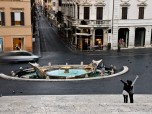The Arch of Titus is the honorific arch of the Roman emperor Titus, who was the older son of Vespasian. The arch was built by Titus’s younger brother Domitian, who followed him as emperor, in about 82 AD. The arch is situated in the Forum Romanum and is one of only two arches to remain standing there. It is the oldest extanting Roman arch. It commemorates the military victories of Titus during his imperial reign, in particular the Siege of Jerusalem in 70 AD.
Ancient and Medieval History
The Jewish revolt against Roman occupation began around 66 AD and lasted for four years. At first, Vespasian was sent to suppress it, but after he had become emperor Titus carried on the work, capturing and then crushing the city between 70 and 72 AD. After Titus’s death in 81 AD, he was granted deification by the Senate; this was a popular move despite Titus’s short reign because he had been known as a just ruler.
Domitian quickly commissioned an arch in his honor, and extensive festivals were held to mark its formal dedication around the year 85 AD. The arch remained largely intact after the fall of Rome in the fifth century. Even in the 11th century it was considered robust enough to be incorporated into a fortified tower built the influential Frangipani family.
Modern History
In early modern times the arch’s condition deteriorated considerably. The first serious restoration was carried out on the arch between 1817 and 1821. The 19th century restoration works on the outer surfaces of the side of the arch were deliberately finished in travertine rather than the Roman marble, with the intention that the restored parts of the structure should be easily distinguishable from the original materials. A considerable amount of new masonry was added, as well as a number of completely new capitals.
Design of the Structure
The identity of the arch’s architect is not known for certain due to the lack of surviving documents or accounts from the period of its construction. However, some modern authorities suggest that the way in which its sculptures are executed may point to Rabirus, who is known to have been a favorite of Domitian.
The arch stands around 50 feet high, and each of the inside surfaces carries a relief honoring Titus. One of these is mythical in tone, with Titus riding in triumph in a chariot, attended by the goddesses Roma and Victoria. The other is more historical, showing the emperor’s procession and the treasures he had taken from Jerusalem’s Second Temple, including silver trumpets and a menorah.
The frieze inscriptions on the outside of the arch were originally cast in bronze, although this metal disappeared many centuries ago. A bronze chariot which stood atop the arch has also been lost. The interior reliefs were originally brightly colored. The inscriptions that describe the arch’s dedication from Rome’s people and Senate to the deified Titus still remain.





































